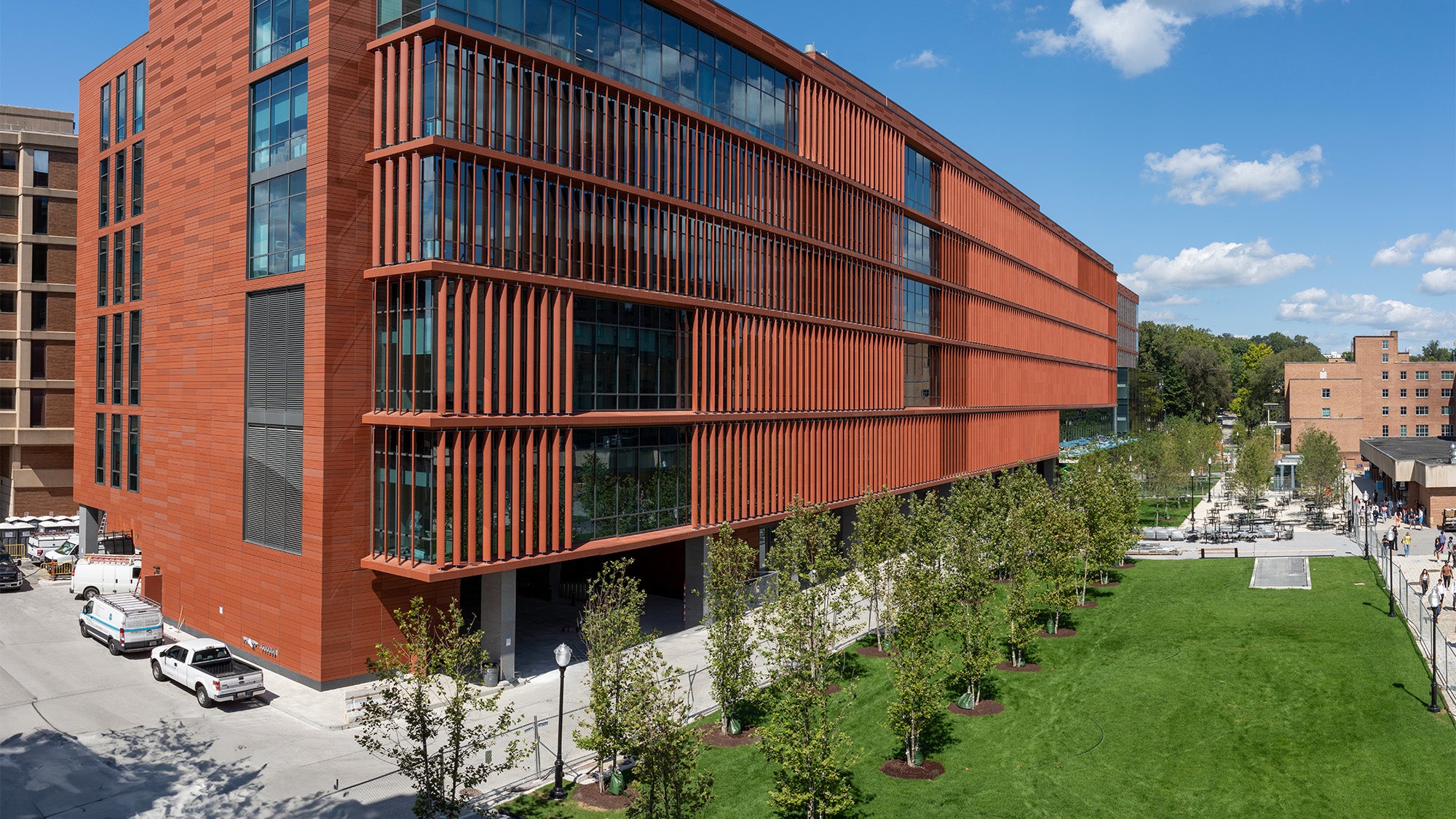School of Nursing’s Special Relationship with MedStar Health Enhances Students’ Clinical Experiences
Top Image: An exterior view of MedStar Georgetown University Hospital’s state-of-the-art Verstandig Pavilion. (All hospital images: MedStar Health)
(May 3, 2024) — Georgetown University and MedStar Health’s academic health system partnership translates into valuable clinical learning experiences for students at the School of Nursing and a robust pipeline of Georgetown-educated nurses for MedStar Health hospitals. MedStar Health is the largest not-for-profit health system in the region; its hospital, MedStar Georgetown University Hospital (MedStar Georgetown), is located just steps from the school.
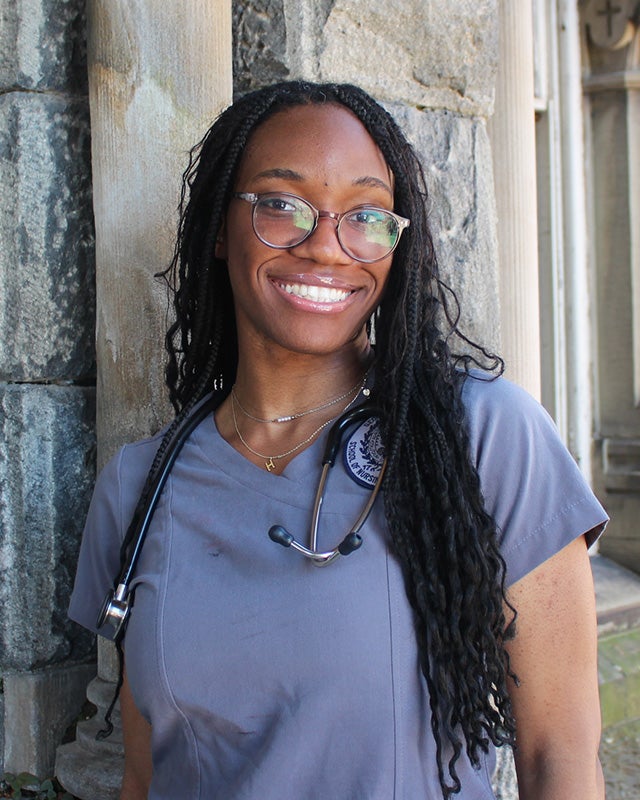
Hannah Ajibola (N’24)
“I came to Georgetown in part because of the school’s special relationship with MedStar, especially at MedStar Georgetown University Hospital,” said Hannah Ajibola (N’24). MedStar Georgetown recently received its fifth consecutive renewal of Magnet Status by the American Nurses Credentialing Center (ANCC), an honor the hospital has maintained for the past 20 years. Magnet status is bestowed upon hospitals that excel in promoting professionalism in nursing and is recognized as the highest accolade hospital nursing can achieve from the ANCC.
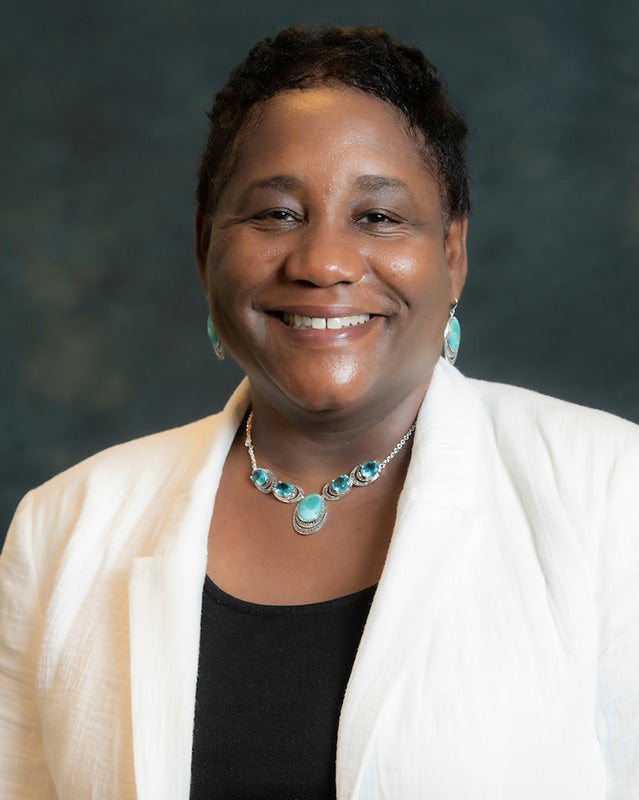
Roberta Waite, EdD, RN
“Georgetown and MedStar Health share a dedication to the pursuit of exceptional patient care, education of the next generation of nurses, ongoing professional development and community well-being,” said Roberta Waite, EdD, RN, PMHCNS, ANEF, FAAN, dean of the School of Nursing. In 2023, Georgetown and MedStar Health established a Joint Council on Nursing to create a framework for expanding the breadth and depth of students’ experiences in caring for populations with diverse health needs and lived experiences.
State-of-the-Art Facilities
Starting in the spring 2024 semester, Georgetown nursing students have had the opportunity to learn in MedStar Georgetown’s state-of-the-art Verstandig Pavilion.
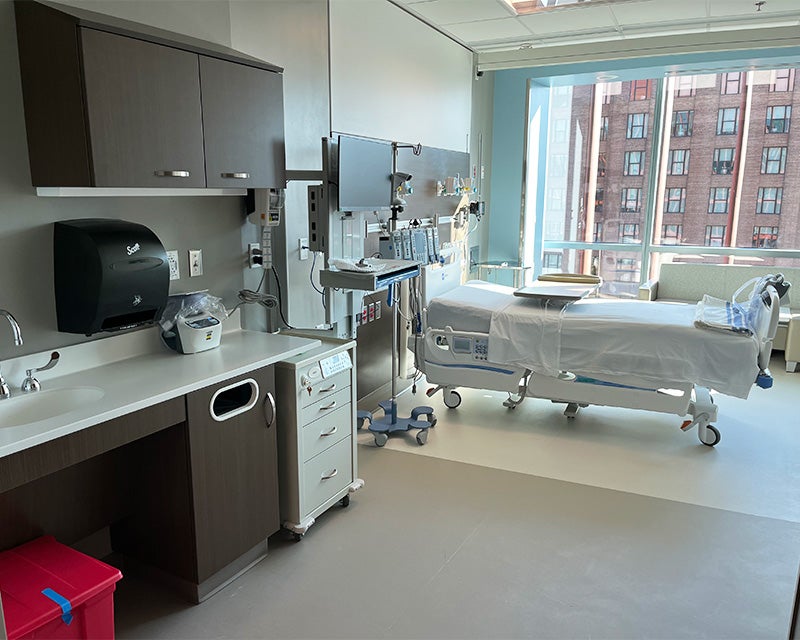
A Level 3 ICU patient room
“We are so lucky to experience the new pavilion,” said Ajibola, who is finishing her senior capstone clinicals in the post anesthesia care unit (PACU). “We now have more space for families who wish to come, as well as single occupancy rooms for surgical patients such as those from pediatrics or patients with contact precautions.”
“The added space for families and visitors at the bedside also provides a unique learning opportunity for our students in collaborating care with the family members present,” said Katherine Cargill, RN, who is an emergency room nurse at Medstar Georgetown and a clinical instructor in the School of Nursing.
“Collaboration between patients, family members, physicians, and nurses is vital for patient outcomes,” added Sarah B. Vittone, DBe, MA, MSN, RN, associate professor and senior program director for undergraduate studies and master of science entry to nursing practice programs.
Ajibola detailed how the larger, more private rooms affected patients as well. “It’s quieter and more comfortable for patients in the PACU who are just waking up from anesthesia and starting their healing,” she said.
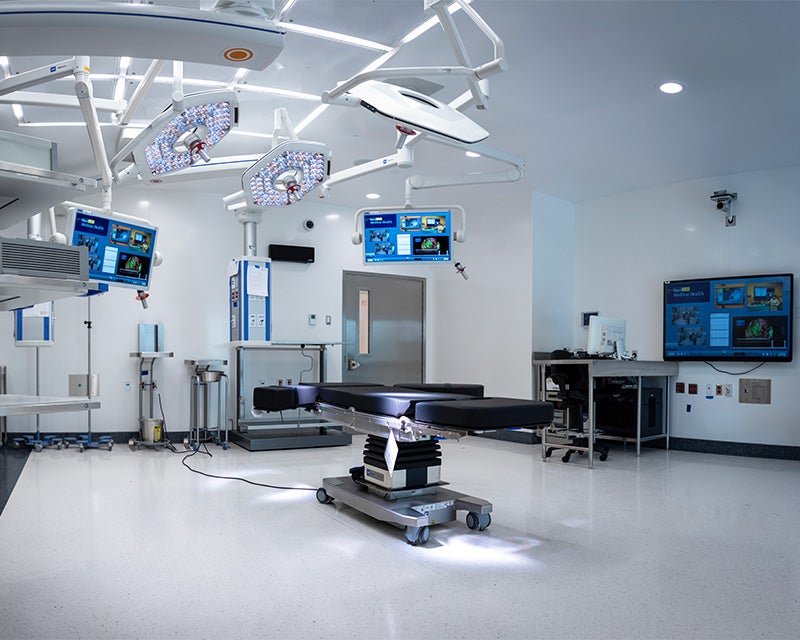
A state-of-the-art operating room
Ajibola also described some of the state-of-the-art technology that nursing students are exposed to during clinicals. “There are screens at the nursing station in the operating room that show what the surgeons are doing with a scope camera,” she said. “It’s a great learning experience to follow along with what was happening to the patient.”
Noah Money (N’24), who is spending his senior capstone clinical rotation in the emergency department in the new pavilion, noticed new safety features on the unit.
“We have five new safe rooms for patients if they are presenting suicidal,” said Money. “In these rooms there are large doors, almost like garage doors, that drop and cover the space so it’s just walls and a bed.”
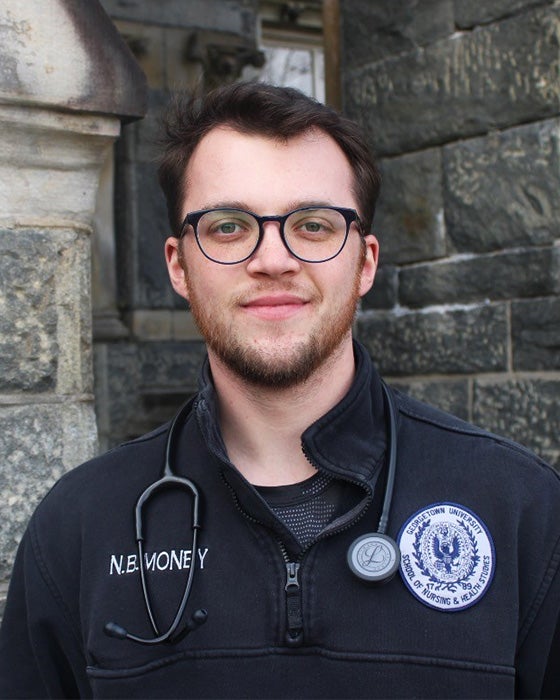
Noah Money (N’24)
Money describes how the enhanced safety features are paired with training in therapeutic de-escalation tactics to create a calm environment for patients.
“The new pavilion with its new technology provides a great hands-on learning experience for our students, so that when they graduate they won’t be surprised encountering this technology at other clinical sites,” said Cargill.
“Launching nurses from their academic program with experience and readiness to practice at the point of care is vital,” said Vittone. “This readiness is supported with the MedStar Georgetown partnership with the School of Nursing.”
Learning by Doing
Bachelor of Science in Nursing (BSN) students have the opportunity to participate in clinical rotations their sophomore through senior years. Graduate nursing students, such as those enrolled in nurse practitioner programs, also have the opportunity for clinical experiences in MedStar Health facilities.

Katherine Cargill, RN
“Georgetown is pretty unique in that our Bachelor of Science students start their clinical rotations their sophomore year when most schools start rotations during students’ junior year,” said Cargill.
“MedStar Georgetown is a partner in many of the BSN students’ clinical courses,” said Vittone. “It is a great location for students to learn evidence-based care in nursing.”
In their final clinical rotation, as part of their senior capstone clinical course, BSN students are paired with a primary nurse preceptor for 144 hours, completing 12-hour shifts to learn what it is like to work in acute or intensive care.

Sarah B. Vittone, DBe, MA, MSN, RN
“Nurses provide oversight and important guidance and supervision as these students care for patients using their new critical thinking skills with a focus on safety, quality, equity and ethics in clinical practice,” said Vittone.
“My preceptor in PACU is great, she gives me the space to practice skills,” said Ajibola. “I’m talking with patients, charting them, getting their meds and anything else they need. I’m becoming more confident in my skills as a nurse after my rotations. “
Ajibola noted Georgetown’s Jesuit values seep through her work in the PACU.
“We focus on holistic care in my unit by connecting with patients as people and understanding their treatment, not just from a medical or pharmacological perspective, but asking about their lives and how they are feeling, and connecting what they share with us to their overall health,” said Ajibola.
In addition to their capstone clinical rotation, students complete a weekly didactic lesson and attend debriefs with their clinical instructors twice a month.
“In the debriefs, we discuss topics that have come up during their rotations, such as the best way to communicate with patients and how to process a patient’s death,” said Cargill. “It’s the first time many students are experiencing things like death, and it can be emotionally straining. But the debriefs provide the space for students to process and feel the normal human feelings that can come with these events.”
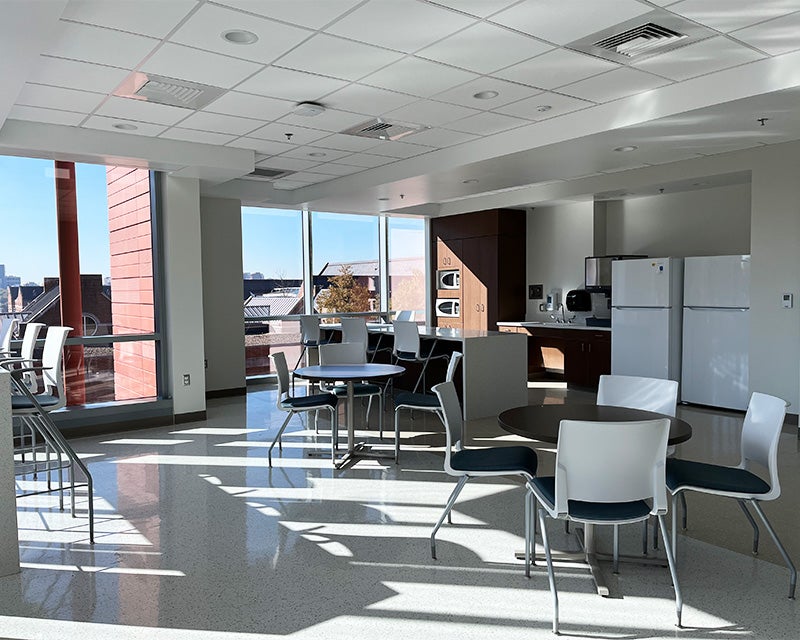
Many of the spaces in the new Verstandig Pavilion, such as this staff break room, incorporate natural light.
As a nursing student, it can be hard to talk to other people who aren’t in nursing about what happens during clinicals,” Money said. “It’s nice to have the debriefs to talk through things with other nursing students who may be experiencing the same thing as you.”
Despite having worked as a cardiac care nurse for 11 years, Kaitlyn Miller (G’24), an adult gerontology acute care nurse practitioner (AG-ACNP) student, valued the experience of working with the transplant team at MedStar Georgetown for her clinical rotation last fall.
“As part of the transplant team, we work with many different departments, surgeons, nephrologists, pharmacists,” said Miller. “It was great to be part of a big team where everyone is so knowledgeable to see how everything comes together.”
A Most Trusted Profession
Every nursing student spoke about the supportive learning environment at MedStar Georgetown that set a standard of care they will carry with them in their future practice as nurses.
“There really is something special about the staff and culture of [MedStar Georgetown] that pushes you and allows for phenomenal clinical experiences,” said Money. “It’s still a community hospital, and people come from all over the city to us because they know they will receive the best care.”
“My clinical rotations remind me why I wanted to go to nursing school — to help people,” said Ajibola. “Just being there with a patient for 12 hours and really cherishing them as a person shows why nursing is one of the most trusted professions and the impact we have on society.”
Heather Wilpone-Welborn
GUMC Communications

